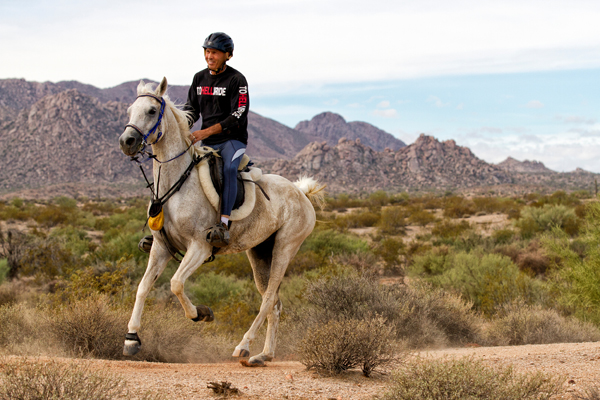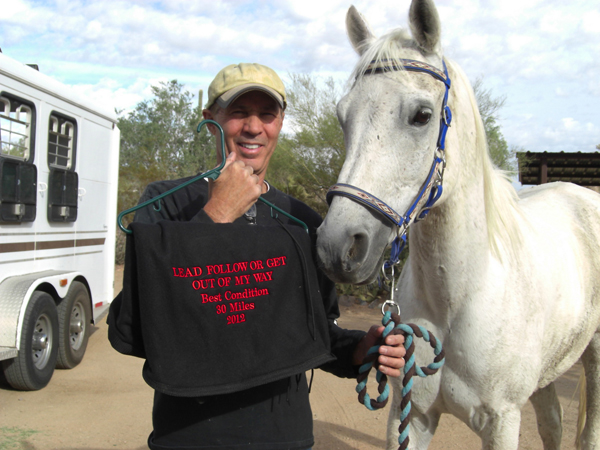Lucian Spataro on Endurance Riding- Dangerous Rides, Award-Winning Horses
Lucian Spataro Shares Lessons Learned in Endurance Riding, Including Dangerous Rides and Award-Winning Horses
In 1989, I rode a team of Arabian horses coast to coast, 2,963 miles in 150 days to bring attention to various environmental issues. As I sit here today writing these words, it is as clear to me today as it was 20 years ago why we made the ride and why I wrote a book about that experience, The Long Ride. You don’t often get a chance in life to “do good” by doing what you love. In 1989, I did get that chance as I had the opportunity to combine my passion for horses and the environment in the “Ride Across America.” Today, I continue to follow both passions. This is the account of my latest adventures in endurance riding.

Lucian and Masquerade riding hard. Photo credit Susan Kordish.
In 2007 I began training a young endurance horse named Masquerade, who I got from my mentor and friend Bazy Tankersley of Al-Marah Arabians. Our first competition was the McDowell Mountain Endurance ride in November, 2008. As we were cantering down the trail, Masquerade tripped on a railroad tie and we went down hard.
Ultimately, I was helicoptered to the hospital for surgery and a search ensued for Masquerade that included over 1,000 search and rescue team members, three helicopters, and a $10,000 reward. Masquerade was found safe and sound (although hungry and thirsty) three days later by local rancher Alex Dorst and his stallion, ironically named Mr. Moneymaker.
Alex promptly paid it forward and donated the $10,000 reward to a local horse shelter. It took Masquerade and me more than a year to recover from the accident and to begin training again. We trained religiously for two years on the trails and washes of McDowell Mountain Park with the objective in mind of competing again in this same race in 2012.
On November 17, 2012 Masquerade and I met the objective that we set back in 2008 after the accident. We competed in the Lead, Follow, or Get out of My Way Endurance Ride at McDowell Mountain Regional Park in Scottsdale, Arizona.
In contrast to the results from our failed attempt at this race in 2008, the 2012 race had lots of training, advance planning, and a well-orchestrated race plan, and for this reason, the outcome was very different. We finished in 6th place overall and Masquerade won the Best Condition award of the TOP TEN finishers! In endurance riding, this is a very important award as it means you did not over-ride your horse and you were training and pacing him properly given the terrain and other horses. Even though five horses finished ahead of us, Masquerade was in the best condition and scored A's and high B's across 10 condition criteria; he did not drink until the final vet check, which was really amazing.
One lesson learned from our accident in 2008 was to always carry a SPOT GPS, so that, if necessary, search and rescue teams can hone in on your location via the signal that is transmitted. The device also allows spectators to follow your race coordinates, giving them real time information on your position in the race on the actual trail you are riding. We had 39 people watch our race on Google via SPOT, and we got great feedback from them on the technology from a spectator’s standpoint.
Forty-six horses started the race, and 37 finished; the rest were pulled by the veterinarians for metabolic and various other reasons. Masquerade and I broke from the pack early in the race on the rocky hill climb. At the 2 mile point, we passed 3 riders and caught a very experienced team, which was very helpful from a tactical standpoint for us as we had been training solo at this pace for a while but not racing against other horses at this pace. How many times in your life do you get the chance to race with professionals for 20+ miles? It was one of those moments that only comes by once, and when it happens you’ve gotta go all in.

Lucian holding Masquerade's award for 'Best Condition'
By the end of the race this beautiful Arabian horse was charcoal black with sweat and dust; I could barely walk and had blisters everywhere imaginable. Nothing gives you more blisters than holding back a 1,000 lbs. horse who wants to lead every horse he catches for 30 miles. Did I mention he hates following other horses?
In endurance racing, when you cross the finish line you aren’t quite finished yet. Your time isn't official until your horse pulses down. Often riders will slow down and trot across the finish line in order of their arrival at the 50 yard out point so that the horses can cool down. This also avoids having horses crashing across a congested finish line and into tents, chairs, timers, vets and other horses.
Once we were over the finish line, I quickly dropped the saddle and threw some water on Masquerade, gave him some hay, and began silently counting back from 200…199, 198, 197...when I could see that he was relaxing, I immediately called for a pulse check. Your time is recorded when your horse hits a resting pulse of 60 beats per minute. Masquerade was able to pulse down in 200 seconds which is remarkable given he was going full throttle for the final eight miles. The 3rd place finisher was disqualified for not pulsing down within the allotted 30 minute period; this allowed us to all move up a notch.
After checking Masquerade’s pulse, the vet turned to me and said with a big smile, “This horse is in great shape, what a great ride, you might BC” (earn Best Condition). This same vet was involved in the search and rescue effort after our accident in the 2008 race. He was excited to see us racing again, especially with such a very different outcome.
Success is not only about training and planning for the event, but also about building a strong rapport with your equine partner. Any experienced horseperson will tell you that there is no shortcut to building this partnership between horse and rider. On both the urban trail and the endurance ride, forging that bond comes from long rides and repetitive exposure to changing stimuli, coupled with lots of ground work as well. All it takes is patient listening, watching, and attentiveness to your horse. This will result in you trusting your horse and your horse trusting you.
About the Author:
Lucian Spataro is the author of The Long Ride: The Record Setting Journey by Horse Across the American Landscape. The book is the recipient of several awards including, the 2012 IPPY Outstanding Book of the Year Gold Award for the book “Most Likely to Save the Planet,” 2012 Benjamin Franklin Bronze Award for Autobiography/ Memoir and 2012 ForeWord Book of the Year Award Finalist in Environment, Nature and Travel Essays. Lucian is the former director of the academic program on “Sustainable Development” at the University of Arizona and continues to speak to civic, business and environmental groups and to students on sustainability. Anyone interested in learning more about "The Long Ride" or endurance riding in general can contact Lucian at Lucian@thelongride.com.




